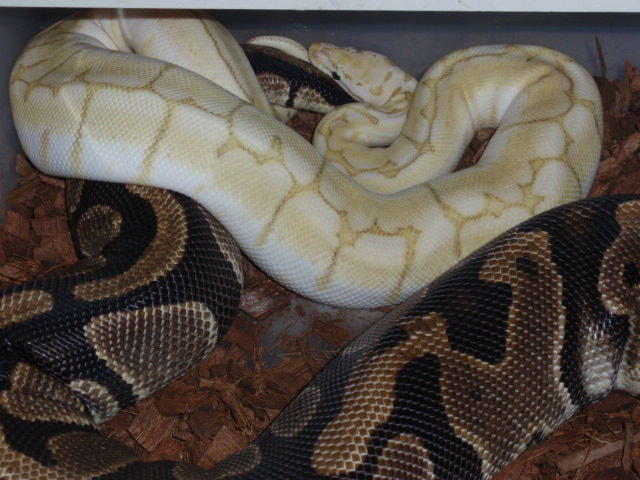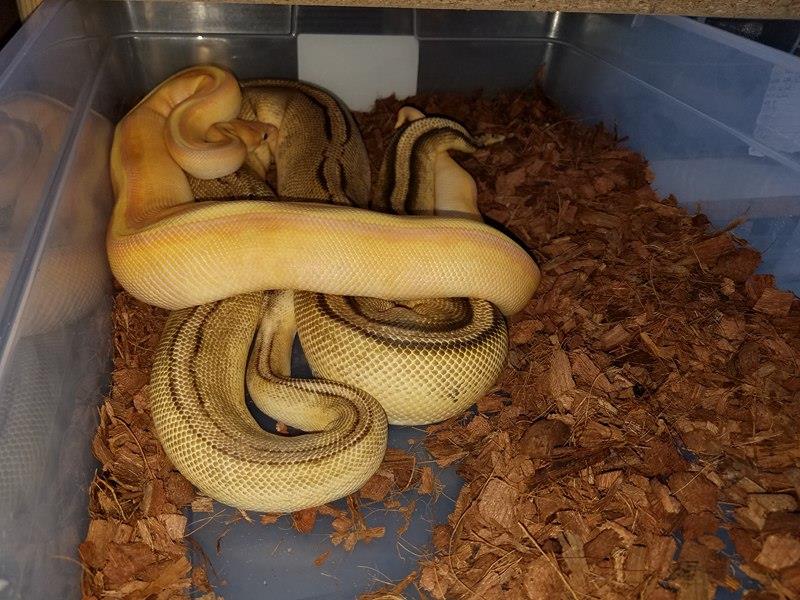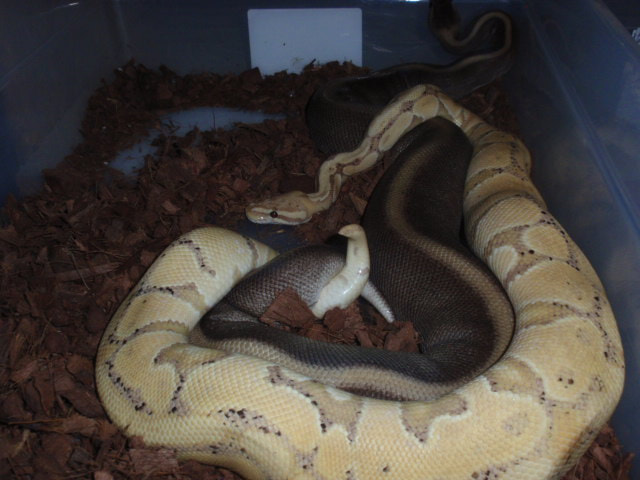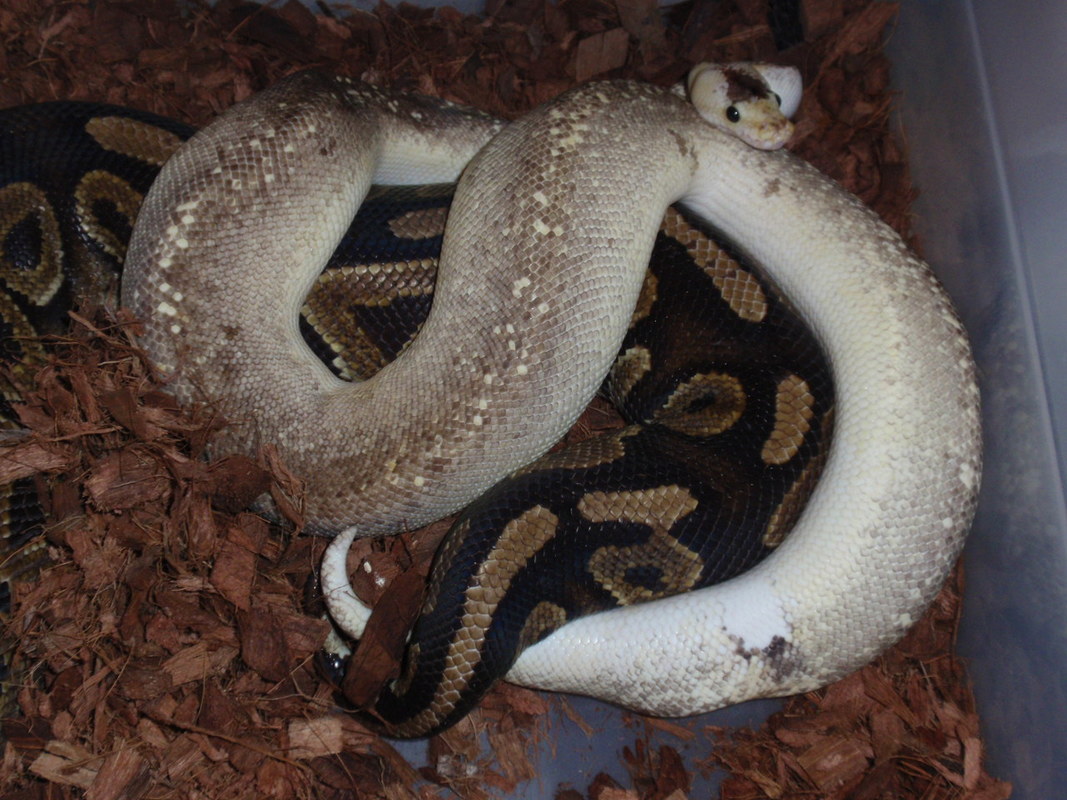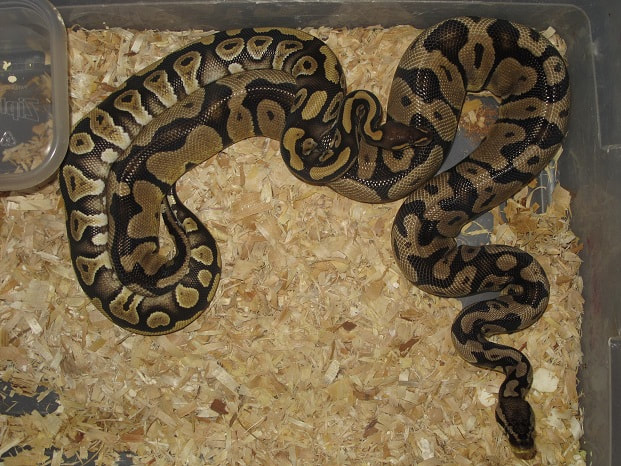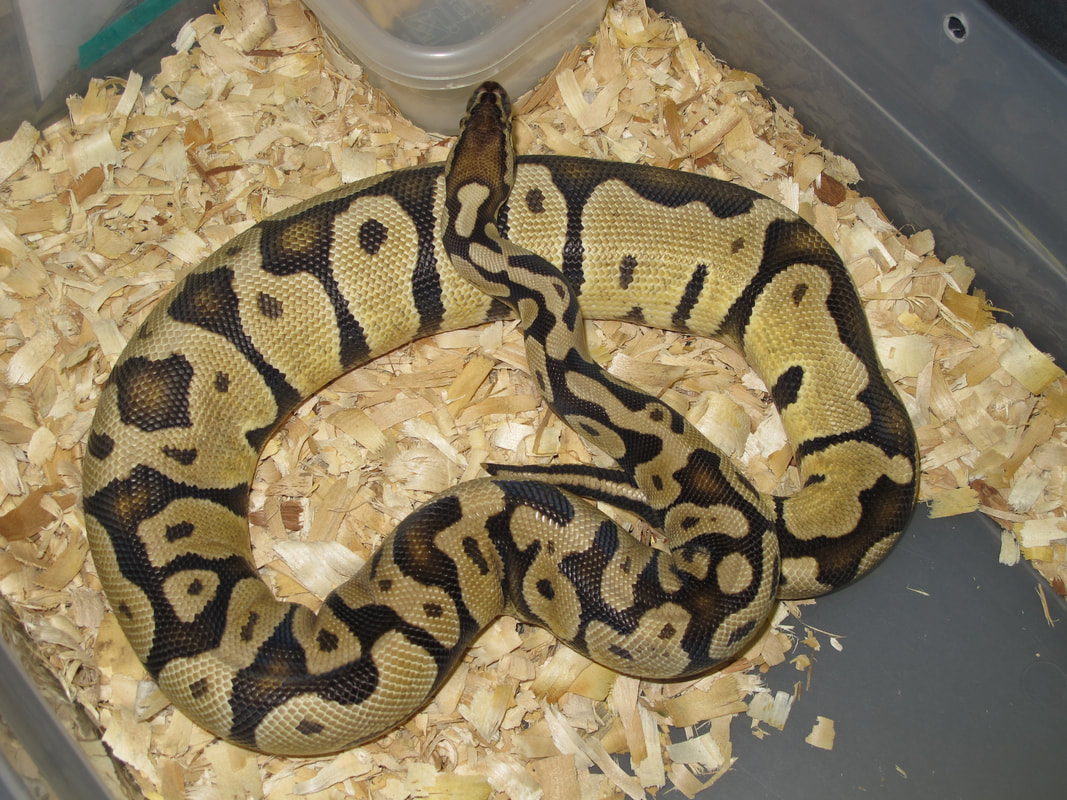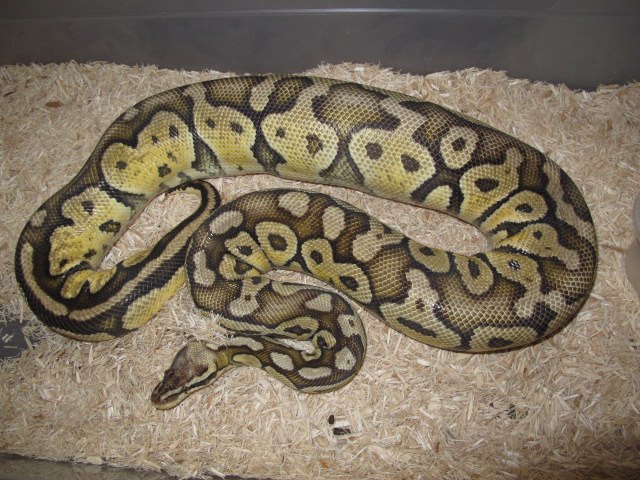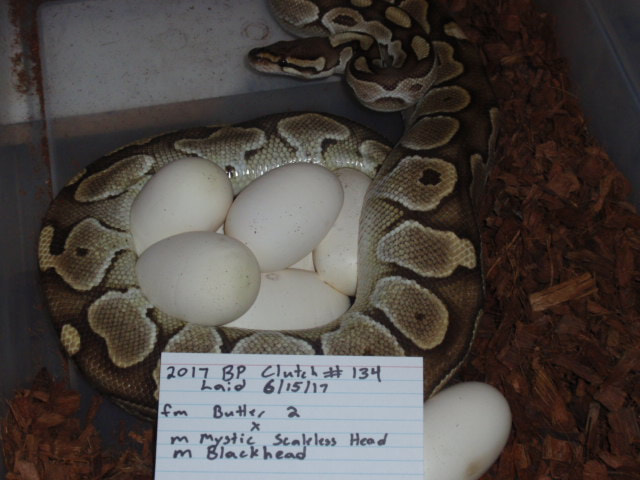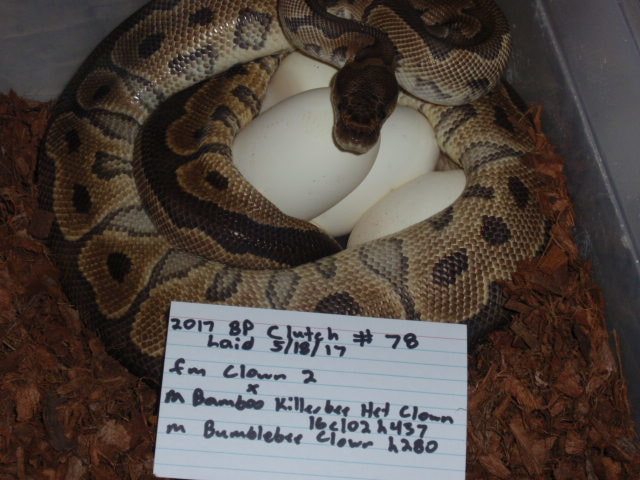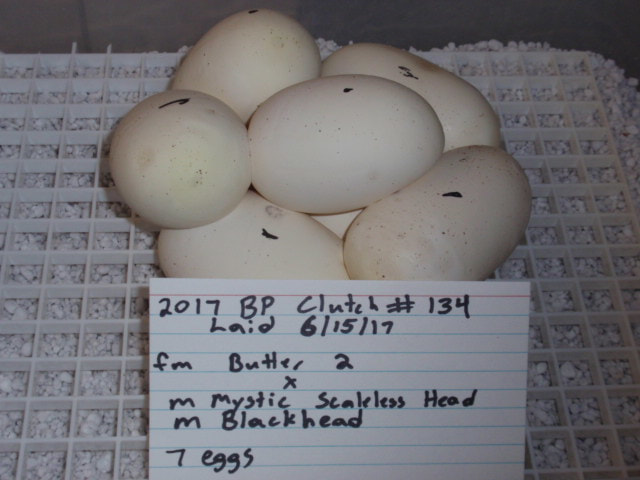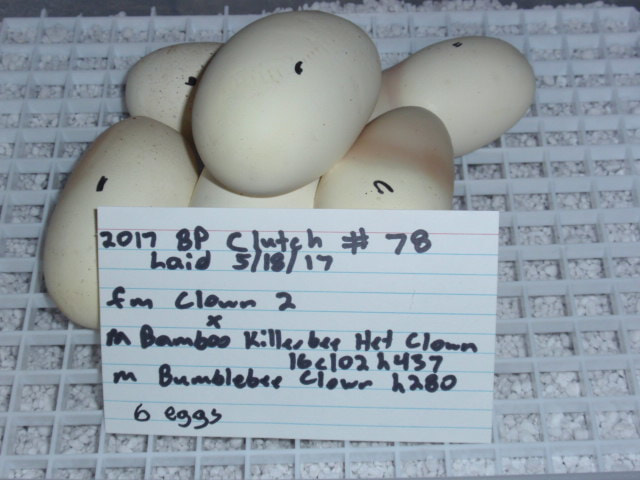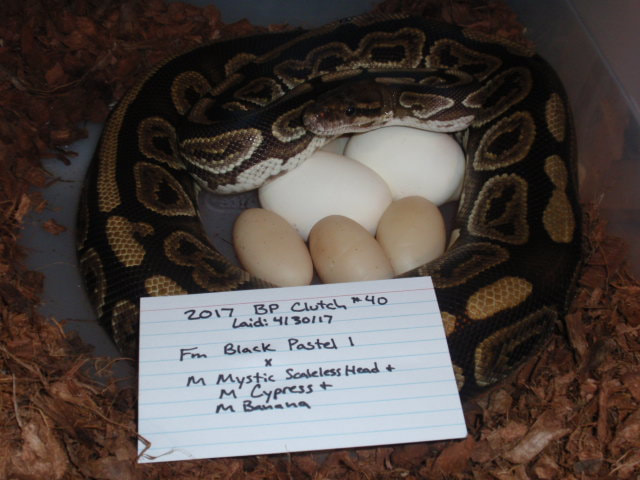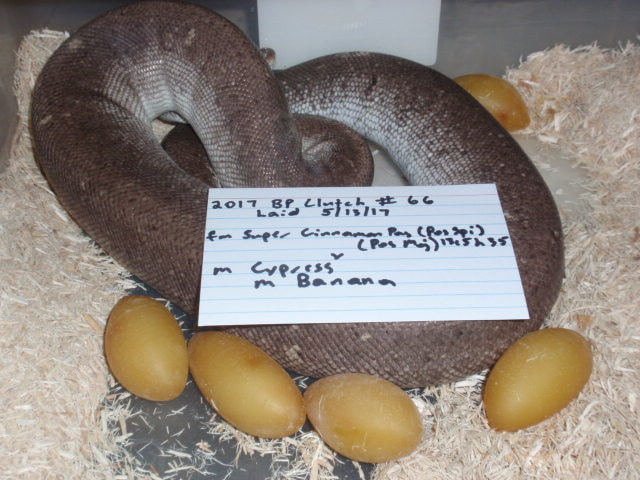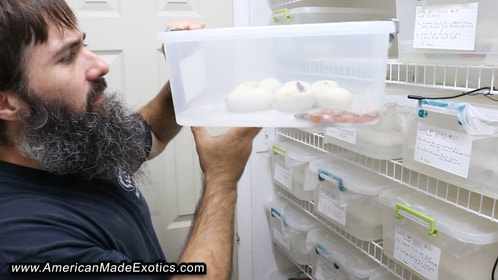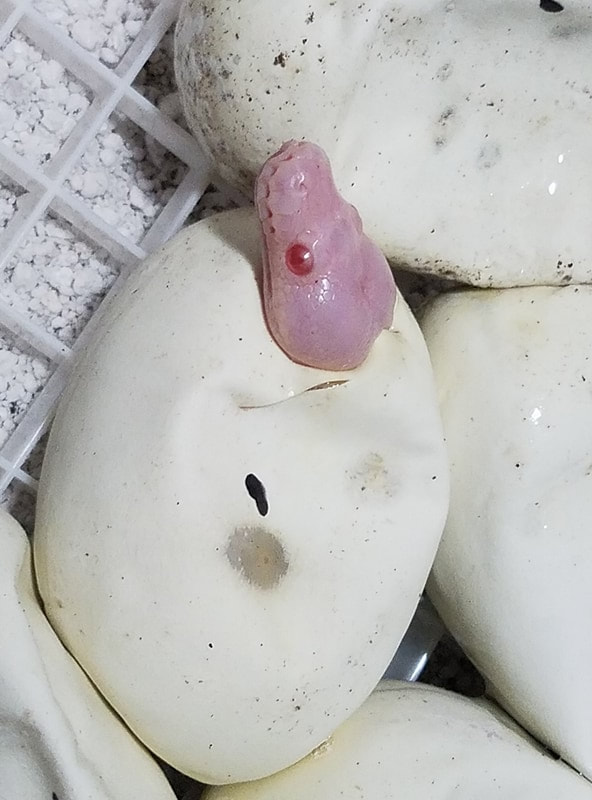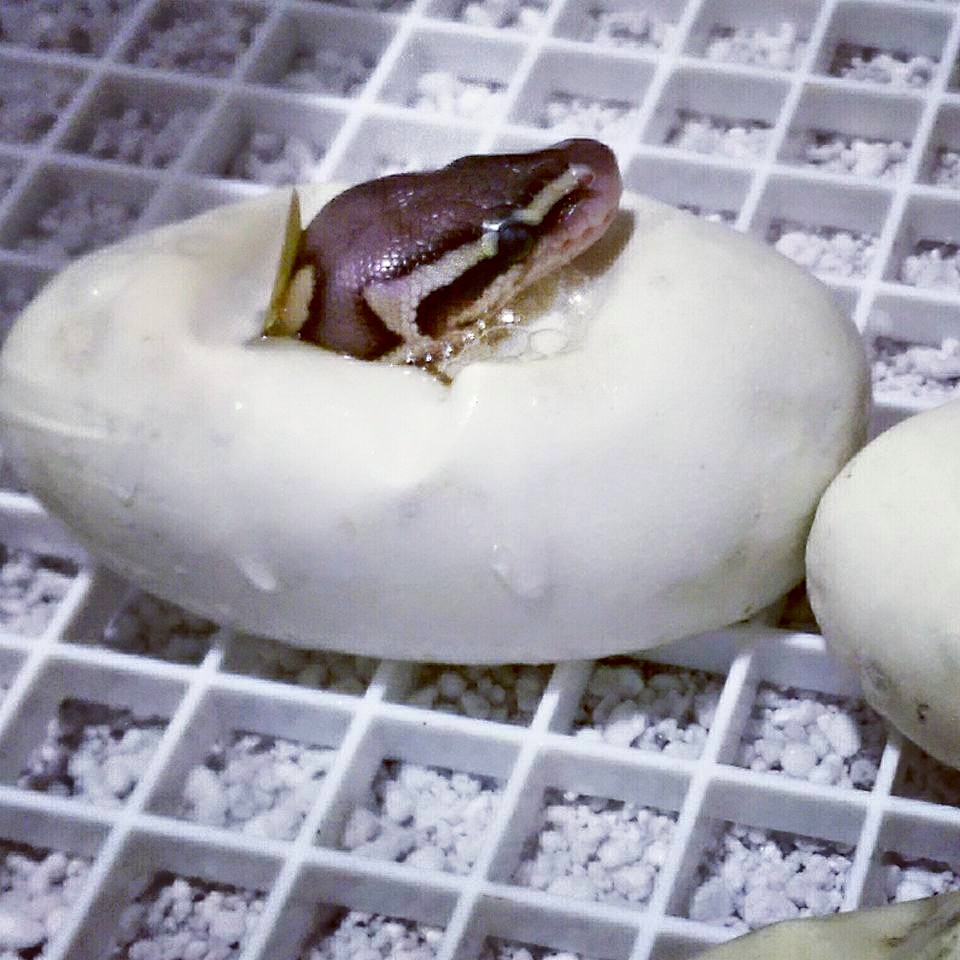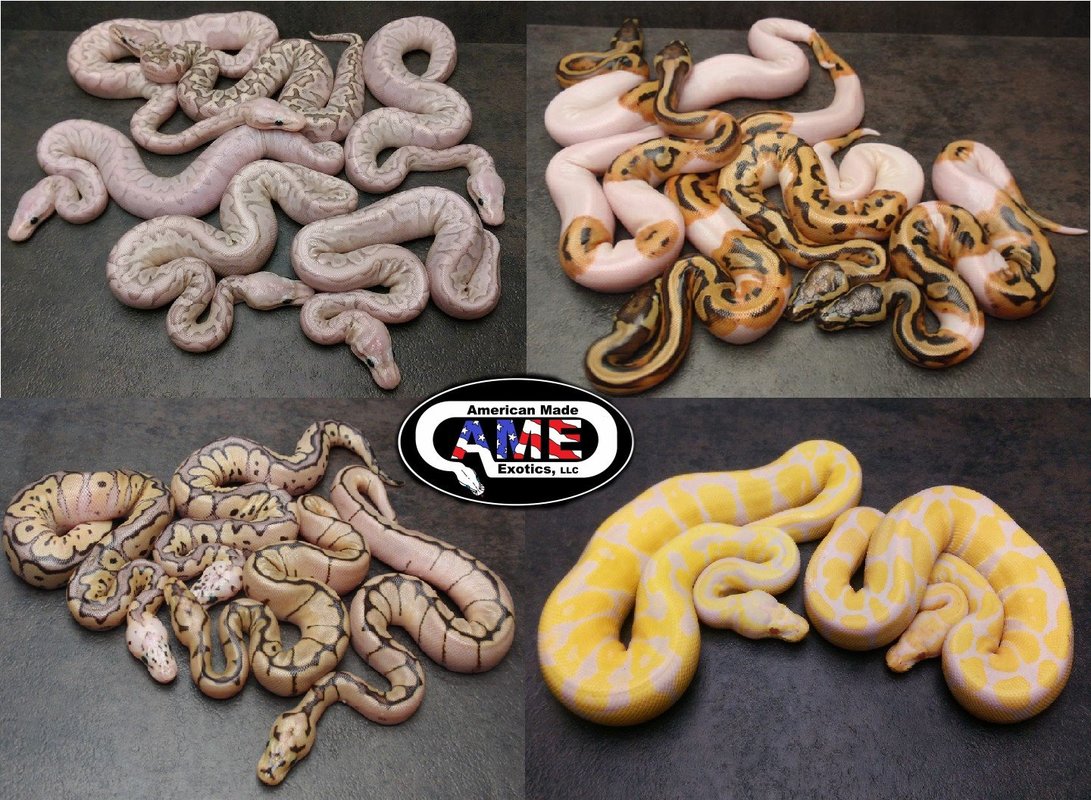How To Breed Ball Pythons
I will start out by saying that this article is how WE breed ball pythons, however there is more than one correct way to breed ball pythons. If you asked 20 different successful breeders how they breed snakes, you will likely get 20 slightly different successful ways to breed snakes as an answer. The best advice we can give is do your research and see how multiple breeders successfully breed ball pythons and find a method that works for you. The following is what works for us. If you do something slightly different, that doesn't necessarily mean that you are wrong.
How To Know When Your Animals Are Ready To Safely Breed
There is no cookie cutter layout on what size the animals need to be to breed safely. There is always exceptions so it's difficult to give an exact weight or age. We go by a combination of age and weight. As a rule of thumb most females will breed in their third winter if they are over 1,500grams. It is possible to see a female hit 1,500g in their second winter but at this point we would let their age come into play when making a decision. If the female is in their second winter we really like to see them above 1,800g to start pairing them. At the same time, a female in her fourth year or older may be 1,500g after laying but still be way too small to breed because she may need to be over 2,000g to have the body weight needed to lay a healthy clutch. This is why it's pretty hard to go just off a weight. With both males and females its very important to take a look at the bigger picture and factor in age, weight and body structure. You don't want an animal that is fat from power feeding, you want the animal to be nice and stocky. You want the snake to be firm to the touch, where they are slow grown versus fat and obese from the keeper trying to grow them as fast as possible. Remember it's not a race to pass 1,500g to breed. All animals are different and they will achieve a healthy, breedable body weight when they are ready.
Over the years, we have learned it's not worth pushing females long term. For example, one year we had 2 sisters both about 1600 grams in their 2nd winter and decided to try and breed them both. One of them laid a small clutch of 4 eggs and lost a lot of weight after doing so while the other female kept feeding and did not lay at all. When the 3rd winter came around the female that laid the year prior had regained the weight she lost before laying and then some but was still under 2k grams while the sister that did not lay in her 2nd winter but kept feeding was pushing 3k grams. When the 3rd season game around again both girls had the weight to breed but the fm that laid in her 2nd winter did not go and the female that stayed on feed and did not lay her 2nd winter went on to drop a nice 10 egg clutch for her first clutch in her 3rd winter. So now when you step back and look at the bigger picture as a whole we have 2 sibling females that were the same size up until we decided to breed them their 2nd winter. The one that gave us eggs early we are going into the 4th winter with her having given us a total of 4 eggs while the sibling that took longer has given us 10 eggs. When you look at it like that sure we didn't get any eggs in the 2nd winter from the female that took longer but in the long run letting her continue to feed and grow has ended up giving us more eggs than the one that started early. At this point we don't even try to push young females because I know by letting them stay on feed and grow larger before pairing them I will end up with the same amount of eggs or more in the long run than if I had pushed her and bred her early. So to us, slow and steady wins the race!
It is possible to get a male to breed his first season. We aim to see a male at least 600g AND STILL FEEDING before trying to breed a young male in his first season. It's not uncommon for males to go off feed completely or to slow down feeding during breeding season. Which is why we aim to see at least 600g and still on feeding before we start pairing a male in his first winter. It is possible to breed a male that is both younger and smaller. The earlier we have ever had a male breeding was about 400g and about 4months old, but we don't really recommend trying this as it's better to have a healthy weight on a snake so that way if he goes off feed during breeding he has enough body weight and fat built up that he doesn't drop to an unsafe weight. Ideally we prefer males to be in their second winter and to be about 800g or more. The key is finding the balance because an underweight male might not have the body weight to be able to safely go off feed and complete the breeding season. At the same time, a male that has been overfed and is too fat will become lazy and have no interest in breeding.
With both males and females, as breeders we always have to keep the health of the animal in mind. Never try to breed a male or female that does not have the body weight. You have to keep an eye on the male and be ready and willing to pull him from breeding rotation if he goes off feed and starts getting thin. It's never worth risking the health of your animals to push them too hard. There is ALWAYS next season IF you put the safety and well being of your animals first!
Over the years, we have learned it's not worth pushing females long term. For example, one year we had 2 sisters both about 1600 grams in their 2nd winter and decided to try and breed them both. One of them laid a small clutch of 4 eggs and lost a lot of weight after doing so while the other female kept feeding and did not lay at all. When the 3rd winter came around the female that laid the year prior had regained the weight she lost before laying and then some but was still under 2k grams while the sister that did not lay in her 2nd winter but kept feeding was pushing 3k grams. When the 3rd season game around again both girls had the weight to breed but the fm that laid in her 2nd winter did not go and the female that stayed on feed and did not lay her 2nd winter went on to drop a nice 10 egg clutch for her first clutch in her 3rd winter. So now when you step back and look at the bigger picture as a whole we have 2 sibling females that were the same size up until we decided to breed them their 2nd winter. The one that gave us eggs early we are going into the 4th winter with her having given us a total of 4 eggs while the sibling that took longer has given us 10 eggs. When you look at it like that sure we didn't get any eggs in the 2nd winter from the female that took longer but in the long run letting her continue to feed and grow has ended up giving us more eggs than the one that started early. At this point we don't even try to push young females because I know by letting them stay on feed and grow larger before pairing them I will end up with the same amount of eggs or more in the long run than if I had pushed her and bred her early. So to us, slow and steady wins the race!
It is possible to get a male to breed his first season. We aim to see a male at least 600g AND STILL FEEDING before trying to breed a young male in his first season. It's not uncommon for males to go off feed completely or to slow down feeding during breeding season. Which is why we aim to see at least 600g and still on feeding before we start pairing a male in his first winter. It is possible to breed a male that is both younger and smaller. The earlier we have ever had a male breeding was about 400g and about 4months old, but we don't really recommend trying this as it's better to have a healthy weight on a snake so that way if he goes off feed during breeding he has enough body weight and fat built up that he doesn't drop to an unsafe weight. Ideally we prefer males to be in their second winter and to be about 800g or more. The key is finding the balance because an underweight male might not have the body weight to be able to safely go off feed and complete the breeding season. At the same time, a male that has been overfed and is too fat will become lazy and have no interest in breeding.
With both males and females, as breeders we always have to keep the health of the animal in mind. Never try to breed a male or female that does not have the body weight. You have to keep an eye on the male and be ready and willing to pull him from breeding rotation if he goes off feed and starts getting thin. It's never worth risking the health of your animals to push them too hard. There is ALWAYS next season IF you put the safety and well being of your animals first!
PAIRING
Ok now that you have decided that you have a male and female or females that have the age and safe body weight to breed it's time to do some pairings!
The number one thing to keep in mind is that ball python breeding season is from Jan 1 - Dec 31.... No that is not a typo, it is possible to get eggs from ball pythons year round. The majority of females will lay from April-June for us but there are ALWAYS females that lay before and after this time frame. We are always on our animals time not the other way around so even though we have a schedule for when we breed the collection as a whole we always have our eyes on our animals to be sure the ones that lay early or late are paired when they need it.
We do not cool our ambient room temp or our hot spots on adults at all. Year round our ambient room temp is about 79-81 degrees and our adult ball pythons are given hot spots of about 88-89 degrees. This lets the females decide when they need to cool themselves and as we go into the breeding season we see more and more females cool seeking and wrapping the water bowls and sitting on the cool side of the tubs.
We usually start pairing late November and try to have the first lock on all of our females by Jan. Once we start pairing we aim for every girl to have a lock on them at least once a month until they ovulation. If not using an ultrasound we usually aim for each male to breed 4-6 females. This allows us to get 1 lock a month per female while still giving the male plenty of down time to rest. If you are using an ultrasound it is possible to safely breed more females per male but you have to stay on a schedule of regularly ultrasounding your females every 3 weeks or so to be sure the girls that need it are getting bred. When using a machine we still aim to get the first lock on the female around late December. We do not pair again until the female hits 15mm follicles or 2 months has gone by, whichever comes first. Then we aim to get 2 more locks on them when they are around 25mm-30mm. We usually do not bother with using the ultrasound other than confirming that a female is starting to absorb her follicles and knowing that although we can feel follicles when palpating there is no point in wasting the males energy breeding her any more as she has started to absorb them and will not go this season.
We always pair our animals by taking the male and putting him in the females enclosure. Some males will lock and get the job done quickly and part ways while others will lock for 24-hours and there is no way you will miss it if you are checking on them. We try to check for locks a few times a day so we can record the locks on the animals breeding tag and document that she was bred even if the male got the job done quickly. If we do not have the time to check for locks a few times that day then we just do not pair that day because if a male locks that female we want to be able to confirm the lock and document it so we can focus his energy on breeding other females in his group that need his attention more. Once we have witnessed copulation and see the snakes are unlocked we will pull the male and offer him a meal and give him several days of rest before trying to breed another female in his breeding group. If we put a pair together and do not see a lock or any signs of courting on the first day we will put that male with another female in his breeding group. If the next day he has not bred or shown any interest in that 2nd female we will just pull him and offer a meal and give him a few days before trying again even though he did not breed.
When a male and female are locked up it is VERY hard to miss. The males tail will be coiled under the females tail and look similar to if crossed your fingers.
We will continue this breeding cycle of aiming for 1 lock on each female until they ovulate or absorb follicles.
The number one thing to keep in mind is that ball python breeding season is from Jan 1 - Dec 31.... No that is not a typo, it is possible to get eggs from ball pythons year round. The majority of females will lay from April-June for us but there are ALWAYS females that lay before and after this time frame. We are always on our animals time not the other way around so even though we have a schedule for when we breed the collection as a whole we always have our eyes on our animals to be sure the ones that lay early or late are paired when they need it.
We do not cool our ambient room temp or our hot spots on adults at all. Year round our ambient room temp is about 79-81 degrees and our adult ball pythons are given hot spots of about 88-89 degrees. This lets the females decide when they need to cool themselves and as we go into the breeding season we see more and more females cool seeking and wrapping the water bowls and sitting on the cool side of the tubs.
We usually start pairing late November and try to have the first lock on all of our females by Jan. Once we start pairing we aim for every girl to have a lock on them at least once a month until they ovulation. If not using an ultrasound we usually aim for each male to breed 4-6 females. This allows us to get 1 lock a month per female while still giving the male plenty of down time to rest. If you are using an ultrasound it is possible to safely breed more females per male but you have to stay on a schedule of regularly ultrasounding your females every 3 weeks or so to be sure the girls that need it are getting bred. When using a machine we still aim to get the first lock on the female around late December. We do not pair again until the female hits 15mm follicles or 2 months has gone by, whichever comes first. Then we aim to get 2 more locks on them when they are around 25mm-30mm. We usually do not bother with using the ultrasound other than confirming that a female is starting to absorb her follicles and knowing that although we can feel follicles when palpating there is no point in wasting the males energy breeding her any more as she has started to absorb them and will not go this season.
We always pair our animals by taking the male and putting him in the females enclosure. Some males will lock and get the job done quickly and part ways while others will lock for 24-hours and there is no way you will miss it if you are checking on them. We try to check for locks a few times a day so we can record the locks on the animals breeding tag and document that she was bred even if the male got the job done quickly. If we do not have the time to check for locks a few times that day then we just do not pair that day because if a male locks that female we want to be able to confirm the lock and document it so we can focus his energy on breeding other females in his group that need his attention more. Once we have witnessed copulation and see the snakes are unlocked we will pull the male and offer him a meal and give him several days of rest before trying to breed another female in his breeding group. If we put a pair together and do not see a lock or any signs of courting on the first day we will put that male with another female in his breeding group. If the next day he has not bred or shown any interest in that 2nd female we will just pull him and offer a meal and give him a few days before trying again even though he did not breed.
When a male and female are locked up it is VERY hard to miss. The males tail will be coiled under the females tail and look similar to if crossed your fingers.
We will continue this breeding cycle of aiming for 1 lock on each female until they ovulate or absorb follicles.
4 Examples Of Visually Confirmed Locks
The males tail is visually twisted under the females tail and looks similar to crossing your fingers. At this point it is best to give them some privacy and leave the pair alone.
This is a good sign to see a male showing courting behavior. Hopefully a visually confirmed lock is not to far away! The male is pressing his belly against the female and showing interest in breeding. Hopefully it is not long before he persuades the female to being receptive to his attempt and the pair locks up.
|
OVULATION and PRE LAY SHED
Now that you have gotten some locks on your female you may notice that her behavior and possibly even appearance have started to change. Females that are starting to build follicles will begin cool seeking and spending more and more time away from the heat and coiled up on the cool side of her enclosure. Many times they will wrap the water bowl or have their bellies inverted into the air. These are all good signs that your male is getting the job done and you are possibly going to see some eggs this season!
The appearance of your female may even begin to change a little. They sometimes will get a "lumpy" look to them as they uncomfortably wrap the water bowl or invert their bellies into the air. During the building process most females will go through a phase where they literally are coming out of the tub looking for the next meal and seem to become bottomless pits only to suddenly turn their nose up at all rodents and not show any interest at all. The other change you may notice to their appearance is that the female may have a bright glowing look to her as she sits there tightly coiled up. I remember reading on all the forums etc when I first started out the term given to this being "they glow before they go" and it does tend to be true with a lot of females. Sometimes even a normal could have a nice BRIGHT glowing look to her as she sits there coiled up!
Ball pythons can retain sperm so every lock that you have witnessed, the female has been storing the sperm as her follicles develop and grow. Now we approach the moment of ovulation which I tend to see usually occur around once the follicles have reached around 40mm range. Ovulation is the process where the sperm and follicles finally meet and you get fertilized eggs that you just have to patiently wait to be laid.
After ovulation the female will enter her pre lay shed cycle and shed about 2-3 weeks after ovulation. Once she sheds her pre lay shed she will lay her clutch right about 30 days. We have seen females lay sooner a few times and later than 30 many times but every year we see the good majority of females lay exactly 30 days after their pre lay shed. You may drive yourself crazy looking for a female to be sitting on a pile of eggs after that 30 day mark but it is not uncommon to see a girl take a little longer sometimes
The appearance of your female may even begin to change a little. They sometimes will get a "lumpy" look to them as they uncomfortably wrap the water bowl or invert their bellies into the air. During the building process most females will go through a phase where they literally are coming out of the tub looking for the next meal and seem to become bottomless pits only to suddenly turn their nose up at all rodents and not show any interest at all. The other change you may notice to their appearance is that the female may have a bright glowing look to her as she sits there tightly coiled up. I remember reading on all the forums etc when I first started out the term given to this being "they glow before they go" and it does tend to be true with a lot of females. Sometimes even a normal could have a nice BRIGHT glowing look to her as she sits there coiled up!
Ball pythons can retain sperm so every lock that you have witnessed, the female has been storing the sperm as her follicles develop and grow. Now we approach the moment of ovulation which I tend to see usually occur around once the follicles have reached around 40mm range. Ovulation is the process where the sperm and follicles finally meet and you get fertilized eggs that you just have to patiently wait to be laid.
After ovulation the female will enter her pre lay shed cycle and shed about 2-3 weeks after ovulation. Once she sheds her pre lay shed she will lay her clutch right about 30 days. We have seen females lay sooner a few times and later than 30 many times but every year we see the good majority of females lay exactly 30 days after their pre lay shed. You may drive yourself crazy looking for a female to be sitting on a pile of eggs after that 30 day mark but it is not uncommon to see a girl take a little longer sometimes
2 Examples Of Females in Ovulation
When a ball python female starts ovulation she will sometimes literally look like she has eaten a football! It is especially noticeable because normally a female has not even eaten for a few weeks or months before ovulation starts. There are always exceptions to every rule though and we have seen females feed regularly up until ovulation but it is not nearly as common as a short period of fasting once the follicles start getting some size on them. Also notice the tail suck appearance caused by the extreme swelling in the lower 1/3 of the body as the follicles are fertilized and become soon to be laid eggs.
INCUBATION
At this point it is time to incubate your eggs! We always start by carefully removing the female from her clutch. Normally she will be wrapped around them and hugging them tightly. Most girls will hiss and posture but we rarely actually get bit removing her from the eggs. The key is just don't hesitate and give her a chance to bite you just reach down behind her and start unwrapping her from the eggs. Once we remove her from the clutch we place her in an empty tub while we set the eggs up and we will come back to her shortly. The first thing we do to the eggs is take a sharpie and put a dot on the side that is facing up on every single egg. We were always told if you roll the eggs when setting them up they could die but I have seen plenty of females have loose eggs move around before pulling her off and those eggs always still hatch. We have heard it both ways that you don't need to worry about which way faces up when putting them in the egg box or that they will go bad if you don't set them up in the egg box facing the same direction as they were laid and honestly aren't sure which method is true. I have always looked at it like this, I worked hard raising the animals and pairing them to get those eggs and it's just not that much effort to put a dot on the top of the egg and set it up in the box the same way they were laid so why risk it to find out? I will say though I have seen numerous eggs loose and rolling around a hissing female and those eggs still hatched if they candled good.
At this point throw away any slugs which are unfertilized eggs that never had a chance. They are very small and have a beige/yellowish tint to them and feel a bit waxy compared to a regular fertilized white egg. Slugs can be caused by a female not having the weight for all the follicles to be fertilized or from improper temperatures in either the female or males enclosure. High heat kills sperm. A male that is kept in to hot of an enclosure may lock but not have adequate sperm to fertilize the follicles during ovulation. High temps in the females enclosure may mean the male did his job but the sperm was killed from the heat while stored waiting for ovulation and there wasn't enough left to fertilize the follicles and produce eggs. At this point we candle our eggs to see which ones are fertile because it is possible to also have an egg that actually developed to look identical to a fertile egg until you candle it. If you cut the lights out or go into a dark room and put a small flash light up to each egg the fertile ones will be full of veins while the infertile ones will light up yellow and be completely empty with no veins. If the eggs are loose we will pull any infertile ones and throw them away simply because we know they will just go bad and mold. If the eggs are all connected and the infertile ones are in the middle of the lump and can not be pulled apart without potentially risking tearing a good egg then we just write INFERTILE or a big X on that egg and leave it. The only reason I write something on these eggs is so when I notice them starting to go bad during the incubation process I know it's nothing we did and the egg was infertile to begin with. Very rarely do we see eggs that candle fertile go bad during incubation, even if butted up against an infertile egg that is covered in mold. Every once in awhile though you will see a fertile egg go bad and sometimes it is just something that happens and you did not do anything wrong.
At this point we will set up our egg box. When it comes to setting up eggs we have seen it done MANY different ways. There are many ways to set up an egg box properly and this is what works for us.
We always use 12qt latch lid sterilite boxes and mix our egg box with 300g perlite and 150g water. We mix that up very well so the moisture is spread evenly and then level the perlite out in a way that all the edges are slightly higher than the middle of the box. We then take the egg crate light diffuser from lowes or home depot that is basically a 2' x 4' sheet of tiny squares and cut it to fit in the 12qt box so that the edges of the egg crate rest on the hills we built up on the edges of the box and the whole middle of the egg crate is not touching any substrate at all. We set our eggs up in the middle of the egg crate so their is air under the eggs as well as all around it. We are just trying to keep the eggs off the moisture. If the eggs are all stuck together then we leave them stuck together and usually don't have to worry about them rolling since they were laid on a flat surface and stuck together in a way that they sit stable on a flat surface. If there are any eggs that were laid loose from the bunch we cut plastic drinking straws and wedge them at an angle on each side of the egg down through the egg crate and into the perlite to create "egg holders" to keep the loose eggs from rolling around. Once we have determined we have fertile eggs we need to incubate and they are sitting in our egg box in a way they won't roll around we we seal the box with press-n-seal to hold all the moisture and humidity in our box and place it into our incubator.
We incubate our ball pythons at 88 degrees and usually see them starting to hatch at about day 55-58. There is a lot of controversy over cutting ball python eggs. Many people argue that you should cut ball python eggs to avoid any animals drowning in the egg. WE DO NOT EVER cut ball python eggs before the clutch begins to hatch on it's own. There is just no point to us, but to each their own. If you feel you really need to cut we suggest waiting until the 2nd baby in that clutch has pipped on it's own. Likely the rest of the clutch will be pipping right behind it but if you are one of the people that insists on cutting to avoid a baby that does not have an egg tooth or is to weak to pip drowning, unless you cut at least when the 2nd baby pips you know you are not cutting way too early and likely could not cause to much damage. We do not recommend cutting eggs though. They hatch on their own just fine in nature and hatch just fine on their own in captivity. To us the only reason people cut is lack of patience finding out what they have hatched. Yes it is VERY exciting to see babies hatch but I promise they will be the same morphs or combos when they come out of the egg on their own as they were in the egg if you cut them open. This is a to each their own type thing and it is just not something we see any benefit in doing at all but we won't knock anybody that feels differently. It is our opinion.
OK NOW BACK TO THAT FEMALE THAT JUST LAID HER EGGS THAT WE LEFT IN AN EMPTY TUB!
Once we set the eggs up and have them safely in the incubator it is time to set that female that just laid up so that she can get back on feed and start building that body weight back up! The first thing we do is a full clean and scrub down on the females tub. We wash the tub with soap and water and give it a good scrub and then finish it off sterilizing it with a scrub down of f10 disinfectant. What we are doing is not only cleaning the tub but we are getting the smell and pheromones from the breeding season completely washed away and giving her a nice clean tub. Then we will take the female herself and wash her body with soap and water and get all the pheromones from the breeding season and laying eggs off her as well. Many times if you skip these steps and set the snake back up in her enclosure she will not eat or will eat unregularly. This is because by instinct after the snake lays eggs she is programmed to stay wrapped around those eggs and keep them safe vs wander off looking for food to replenish the body weight she lost. Many times if you do not give the tub a good scrub down and wash the female with soap and water she will still sit coiled up programed to not go looking for food even though her eggs are gone and set up safely in an incubator. Scrubbing the tub and the female seems to just snap them out of it and go right back into feeding mode so you can fatten her back up to a healthy weight.
At this point throw away any slugs which are unfertilized eggs that never had a chance. They are very small and have a beige/yellowish tint to them and feel a bit waxy compared to a regular fertilized white egg. Slugs can be caused by a female not having the weight for all the follicles to be fertilized or from improper temperatures in either the female or males enclosure. High heat kills sperm. A male that is kept in to hot of an enclosure may lock but not have adequate sperm to fertilize the follicles during ovulation. High temps in the females enclosure may mean the male did his job but the sperm was killed from the heat while stored waiting for ovulation and there wasn't enough left to fertilize the follicles and produce eggs. At this point we candle our eggs to see which ones are fertile because it is possible to also have an egg that actually developed to look identical to a fertile egg until you candle it. If you cut the lights out or go into a dark room and put a small flash light up to each egg the fertile ones will be full of veins while the infertile ones will light up yellow and be completely empty with no veins. If the eggs are loose we will pull any infertile ones and throw them away simply because we know they will just go bad and mold. If the eggs are all connected and the infertile ones are in the middle of the lump and can not be pulled apart without potentially risking tearing a good egg then we just write INFERTILE or a big X on that egg and leave it. The only reason I write something on these eggs is so when I notice them starting to go bad during the incubation process I know it's nothing we did and the egg was infertile to begin with. Very rarely do we see eggs that candle fertile go bad during incubation, even if butted up against an infertile egg that is covered in mold. Every once in awhile though you will see a fertile egg go bad and sometimes it is just something that happens and you did not do anything wrong.
At this point we will set up our egg box. When it comes to setting up eggs we have seen it done MANY different ways. There are many ways to set up an egg box properly and this is what works for us.
We always use 12qt latch lid sterilite boxes and mix our egg box with 300g perlite and 150g water. We mix that up very well so the moisture is spread evenly and then level the perlite out in a way that all the edges are slightly higher than the middle of the box. We then take the egg crate light diffuser from lowes or home depot that is basically a 2' x 4' sheet of tiny squares and cut it to fit in the 12qt box so that the edges of the egg crate rest on the hills we built up on the edges of the box and the whole middle of the egg crate is not touching any substrate at all. We set our eggs up in the middle of the egg crate so their is air under the eggs as well as all around it. We are just trying to keep the eggs off the moisture. If the eggs are all stuck together then we leave them stuck together and usually don't have to worry about them rolling since they were laid on a flat surface and stuck together in a way that they sit stable on a flat surface. If there are any eggs that were laid loose from the bunch we cut plastic drinking straws and wedge them at an angle on each side of the egg down through the egg crate and into the perlite to create "egg holders" to keep the loose eggs from rolling around. Once we have determined we have fertile eggs we need to incubate and they are sitting in our egg box in a way they won't roll around we we seal the box with press-n-seal to hold all the moisture and humidity in our box and place it into our incubator.
We incubate our ball pythons at 88 degrees and usually see them starting to hatch at about day 55-58. There is a lot of controversy over cutting ball python eggs. Many people argue that you should cut ball python eggs to avoid any animals drowning in the egg. WE DO NOT EVER cut ball python eggs before the clutch begins to hatch on it's own. There is just no point to us, but to each their own. If you feel you really need to cut we suggest waiting until the 2nd baby in that clutch has pipped on it's own. Likely the rest of the clutch will be pipping right behind it but if you are one of the people that insists on cutting to avoid a baby that does not have an egg tooth or is to weak to pip drowning, unless you cut at least when the 2nd baby pips you know you are not cutting way too early and likely could not cause to much damage. We do not recommend cutting eggs though. They hatch on their own just fine in nature and hatch just fine on their own in captivity. To us the only reason people cut is lack of patience finding out what they have hatched. Yes it is VERY exciting to see babies hatch but I promise they will be the same morphs or combos when they come out of the egg on their own as they were in the egg if you cut them open. This is a to each their own type thing and it is just not something we see any benefit in doing at all but we won't knock anybody that feels differently. It is our opinion.
OK NOW BACK TO THAT FEMALE THAT JUST LAID HER EGGS THAT WE LEFT IN AN EMPTY TUB!
Once we set the eggs up and have them safely in the incubator it is time to set that female that just laid up so that she can get back on feed and start building that body weight back up! The first thing we do is a full clean and scrub down on the females tub. We wash the tub with soap and water and give it a good scrub and then finish it off sterilizing it with a scrub down of f10 disinfectant. What we are doing is not only cleaning the tub but we are getting the smell and pheromones from the breeding season completely washed away and giving her a nice clean tub. Then we will take the female herself and wash her body with soap and water and get all the pheromones from the breeding season and laying eggs off her as well. Many times if you skip these steps and set the snake back up in her enclosure she will not eat or will eat unregularly. This is because by instinct after the snake lays eggs she is programmed to stay wrapped around those eggs and keep them safe vs wander off looking for food to replenish the body weight she lost. Many times if you do not give the tub a good scrub down and wash the female with soap and water she will still sit coiled up programed to not go looking for food even though her eggs are gone and set up safely in an incubator. Scrubbing the tub and the female seems to just snap them out of it and go right back into feeding mode so you can fatten her back up to a healthy weight.
2 Examples Of Slugs
There is no let down greater than going through the process of breeding your snakes to open the tub one day and see your female in a perfect coil mounded up only to uncoil her and realize she is sitting on a clutch of slugs and not a clutch of pearly white eggs! It is part of breeding snakes though and if you breed enough snakes you will certainly be let down eventually. Hopefully when you see your first slugs there are still fertile eggs in the clutch along with them and not a complete slug out by the female! All you can do is try to learn what you did wrong to get the slugs, correct the issue, and try again next season for hopefully better luck next time!
Pics Of One of Our Walk In Incubators
SETTING UP BABIES
Once the babies have hatched they will quickly go into a shed cycle. We separate all of our babies individually into baby racks and let them complete their first shed cycle before offering their first meal. Many times babies will take a rat pink for their first meal but we always prefer to start them out on very small hopper mice. We seem to get a better feeding response out of babies taking their first meal when we offer a small hopper mouse that is moving all over the place and grabbing the babies attention and keeping it until the snake can no longer resist. If a baby does not feed on the first attempt do not be discouraged just try again the next day. NEVER leave a live hopper mouse in for an extended period of time. If the snake refuses a few live hopper mice we will throw in a large live rat pink and leave it in overnight. There is no danger leaving a live rat pink in overnight but NEVER leave a live hopper mouse in with a snake over night.
IN CONCLUSION
Breeding your ball pythons can be one of the most rewarding and exciting aspects of keeping your animals AS LONG AS the safety and the health of your breeders remains your number one concern. No matter how many babies we hatch the excitement of seeing a brand new baby pipping out of the egg just never goes away! These animals are truly living art and there is just no end to the variations and combos of pattern and color we can produce! If you have any questions please do not hesitate to ask. We wish you all the best of luck in your breeding ventures. Again, the above article is how WE do things but there are many ways to breed ball pythons correctly so do your research and see how multiple breeders that are successful do things and find what works for YOU. Most importantly.....Have fun! Thanks for reading!
